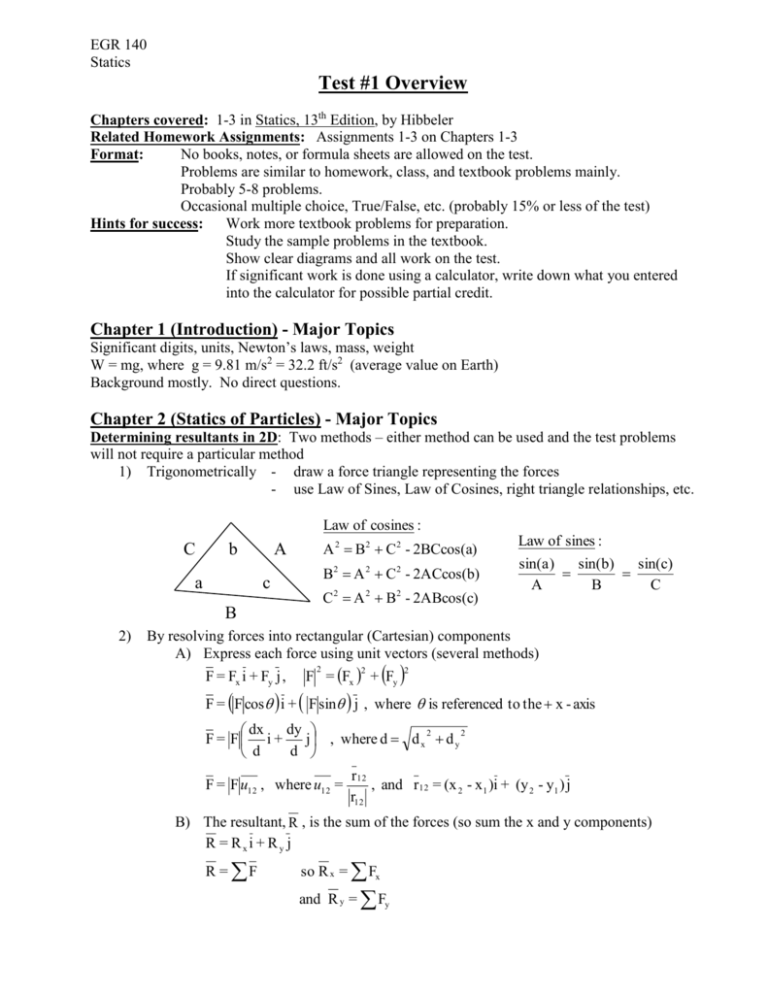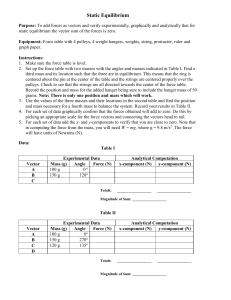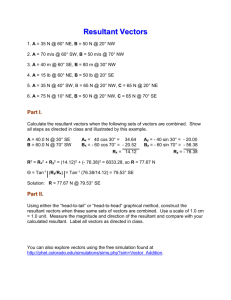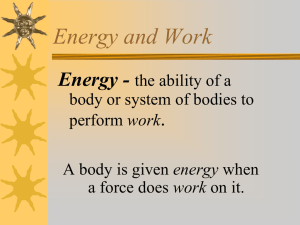Test #1 Overview
advertisement

EGR 140 Statics Test #1 Overview Chapters covered: 1-3 in Statics, 13th Edition, by Hibbeler Related Homework Assignments: Assignments 1-3 on Chapters 1-3 Format: No books, notes, or formula sheets are allowed on the test. Problems are similar to homework, class, and textbook problems mainly. Probably 5-8 problems. Occasional multiple choice, True/False, etc. (probably 15% or less of the test) Hints for success: Work more textbook problems for preparation. Study the sample problems in the textbook. Show clear diagrams and all work on the test. If significant work is done using a calculator, write down what you entered into the calculator for possible partial credit. Chapter 1 (Introduction) - Major Topics Significant digits, units, Newton’s laws, mass, weight W = mg, where g = 9.81 m/s2 = 32.2 ft/s2 (average value on Earth) Background mostly. No direct questions. Chapter 2 (Statics of Particles) - Major Topics Determining resultants in 2D: Two methods – either method can be used and the test problems will not require a particular method 1) Trigonometrically - draw a force triangle representing the forces - use Law of Sines, Law of Cosines, right triangle relationships, etc. Law of cosines : C b a A c A 2 B2 C 2 - 2BCcos(a) Law of sines : B2 A 2 C 2 - 2ACcos(b) sin(a ) sin(b) sin(c) A B C C 2 A 2 B2 - 2ABcos(c) B 2) By resolving forces into rectangular (Cartesian) components A) Express each force using unit vectors (several methods) F = Fx i + Fy j , F = Fx + Fy 2 2 2 F = F cos i + F sin j , where is referenced to the x - axis dy dx 2 2 F = F i + j , where d d x d y d d F = F u12 , where u12 = r12 , and r 12 = (x 2 - x 1 )i + (y 2 - y1 ) j r12 B) The resultant, R , is the sum of the forces (so sum the x and y components) R = Rxi + Ry j R = F so R x = Fx and R y = Fy Page 2 Vectors in 3D: Vectors in 3D are typically expressed using rectangular components. These components are commonly found three ways: 1) Using position vectors: r12 F = F u , where u = , and r12 = (x 2 - x1 )i + (y 2 - y1 ) j + (z 2 - z1 )k r12 or if r12 = (dx )i + (dy) j + (dz)k then dy dz dx 2 2 2 F i + j + k , where d d x d y d z d d d 2) Using direction angles (angles to the x, y, and z angles) F = F cos i + F cos j + F cos k Fx i + Fy j + Fz k F = Fx + Fy + Fz 2 2 2 Fx F cos -1 2 F -1 y -1 F , cos , cos z F F cos 2 + cos 2 + cos 2 = 1 3) Using projection angles (such as the angle onto the horizontal (xy) plane). These angles can also be used to find the x, y, and z components. See examples in the text or class notes. Determining resultants in 3D: R = Rxi + Ry j + Rz k R = F so R x = Fx R y = Fy R z = Fz Dot Products: Definition: A B A B cosθ scalar result Applications: 1) Determining the angle between two vectors A A B A B cos( ) AB cos( ) AB A x Bx A y B y A z Bz A x A y A z B x B y Bz 2 2 2 2 2 B 2 2) Determining the projection of a vector along a line FAB F|| the projection of F along line AB (or parallel to line AB) F F FAB F|| F u AB B expressing the above result using vectors : FAB F|| FAB u AB and F F|| F so F F - F|| F|| A u AB Chapter 3 (Equilibrium of a Particle) - Major Topics Free-Body Diagram (FBD) – a key concept in statics A FBD shows all forces acting on a particle or body. Steps in creating a FBD: 1) Draw a dotted line around the particle or body to be isolated. (If it is on a piece of paper, image cutting in out with scissors.) 2) Represent each rope, cable, weight, support, etc., cut by the dotted line 3) Label each force (and its direction) and include important angles. Equilibrium in 2D: If an object is in equilibrium, then: F 0 so Fx 0 F 0 Equilibrium in 3D: If an object is in equilibrium, then: F 0 so Fx 0 y F F y 0 0 Pulleys: All pulleys considered so in this course have been frictionless. Notes on pulleys: Pulleys are used to redirect a force Ropes and cables are always in tension, so they always pull away from a pulley The tension is the same throughout any rope or cable, so the tension is the same on either side of a pulley. If a pulley system has multiple ropes, label them with different tensions. Be sure to use a FBD to isolate which part of the pulley system is being analyzed with the equations of equilibrium. z Springs: Springs can be used to apply forces of tension (pulling) or compression (pushing). The force in a spring can be determined using Hooke’s Law: F k L - L0 where F spring force k spring constant (in units such as lb/in, lb/ft, N/m, etc) L stretched length of spring L 0 unstretched length of spring Other topics: All topics are not listed above. In general, any topics covered in class, in the textbook, or in homework may be on the test. Calculators: Calculator methods such as the following are very helpful, but are will not be specifically required. Performing the calculations by any technique is sufficient. However, if calculators are used to perform vector functions, it is strongly recommended that you write down whatever you enter into the calculator in order to receive partial credit in case of an error. Using polar and rectangular numbers to represent and add vectors Finding unit vectors Expressing force vectors using unit vectors







